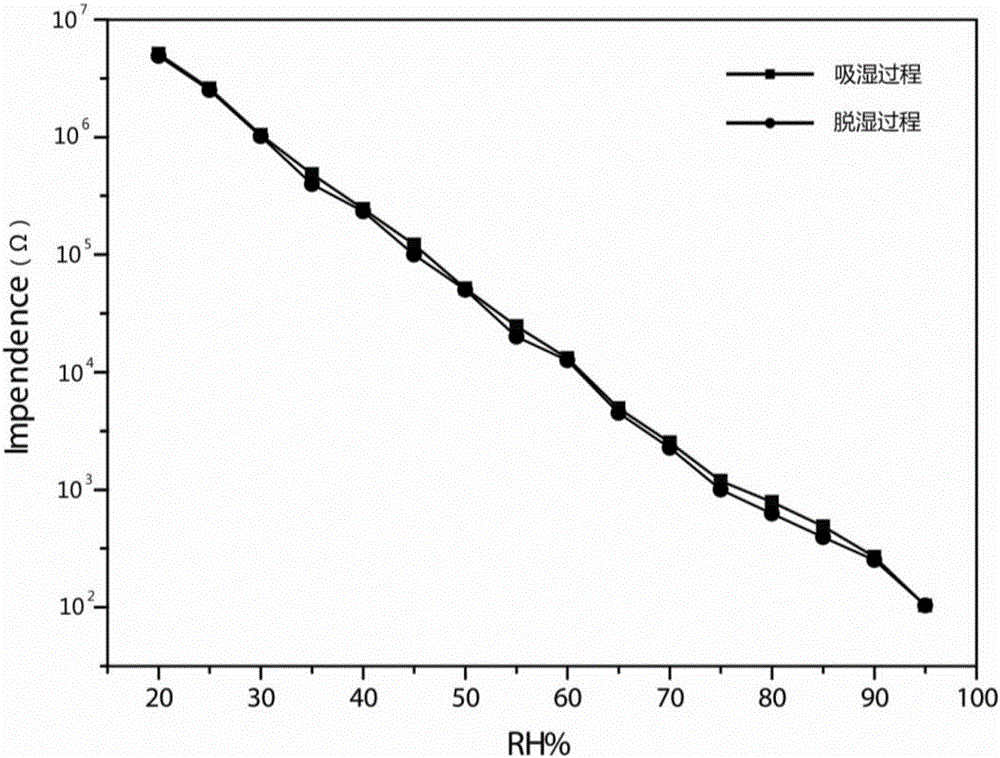Resistive macromolecule humidity-sensitive material and preparation method thereof
A moisture-sensitive material, resistance-type technology, applied in the analysis of materials, material analysis through electromagnetic means, material resistance, etc., can solve problems such as hindering popularization and application, poor high-humidity resistance and long-term stability, and easy slip loss. Achieve good humidity response, high humidity resistance and long-term stability, and improve water resistance
- Summary
- Abstract
- Description
- Claims
- Application Information
AI Technical Summary
Problems solved by technology
Method used
Image
Examples
Embodiment 1
[0037] Take 20 parts of acryloyloxyethyltrimethylammonium chloride, 10 parts of acrylamide, 10 parts of methyl methacrylate, 2 parts of lithium acrylate, and 0.5 parts of initiator AIBN, and place it in a Add methanol to the four-necked flask of the condenser tube and the nitrogen protection device to completely dissolve the reactants, and then react at a constant temperature of 65-85° C. for 4 hours. After the reaction is finished, the obtained product is washed with ether, and then vacuum-dried at room temperature to obtain a resistive polymer moisture-sensitive material.
Embodiment 2
[0039] Take 20 parts of methacryloyloxyethyltrimethylammonium chloride, 40 parts of diethylaminoethyl methacrylate, 10 parts of styrene, 2 parts of sodium styrene sulfonate, 1 part of initiator AIBN, and place in a Methanol was added to a four-necked flask with a thermometer, a stirrer, a reflux condenser and a nitrogen protection device to completely dissolve the reactant, and then reacted at a constant temperature of 65-85° C. for 6 hours. After the reaction, the obtained product was washed with ether and dried in vacuum at room temperature to obtain a resistive polymer moisture-sensitive material.
Embodiment 3
[0041] Take 20 parts of methacryloylpropyltrimethylammonium chloride, 20 parts of dimethyl allylamine, 10 parts of methyl acrylate, 5 parts of sodium styrene sulfonate, and 0.8 parts of initiator AIBN, and put them in the Add methanol to a four-necked flask equipped with a thermometer, a stirrer, a reflux condenser and a nitrogen protection device to completely dissolve the reactants, and then react at a constant temperature of 65-85° C. for 6 hours. After the reaction, the obtained product was washed with ether and dried in vacuum at room temperature to obtain a resistive polymer moisture-sensitive material.
PUM
 Login to View More
Login to View More Abstract
Description
Claims
Application Information
 Login to View More
Login to View More - R&D
- Intellectual Property
- Life Sciences
- Materials
- Tech Scout
- Unparalleled Data Quality
- Higher Quality Content
- 60% Fewer Hallucinations
Browse by: Latest US Patents, China's latest patents, Technical Efficacy Thesaurus, Application Domain, Technology Topic, Popular Technical Reports.
© 2025 PatSnap. All rights reserved.Legal|Privacy policy|Modern Slavery Act Transparency Statement|Sitemap|About US| Contact US: help@patsnap.com



